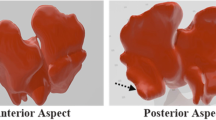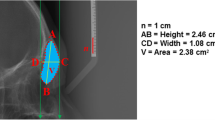Abstract
Frontal sinuses are of special interest for personal identification thanks to their high variability. A common procedure for comparing ante-mortem and post-mortem material is based on coding systems classifying frontal sinuses according to their morphological and metrical characteristics. However, the calculation of possible combinations is performed on the hypothesis that all the classified features are independent one from each other. This study aims at analysing the correlation among morphological and metrical characteristics of frontal sinuses. Two hundred CT scans of patients equally divided between males and females were segmented through the ITK-SNAP software. Number of accessory septations, scalloping and supra-orbital cells, side asymmetry and superiority, breadth, height, length and volume were extracted from the frontal sinuses of each subject. A possible relationship among morphological and metrical features was analysed through Pearson’s correlation test, Mann-Whitney test or chi-square test according to the type of compared data (p < 0.05). In general, a positive correlation was found for all comparisons among metrical measurements (breadth, height, depth and volume) and number of septations, scalloping and supra-orbital cells (p < 0.05), but not between the number of scalloping and supra-orbital cells. In addition, side of asymmetry was positively related with side of superiority of the upper profile of frontal sinuses (p < 0.05). This study proved that morphological and metrical characteristics of frontal sinuses are strictly related one with each other: therefore, the coding systems based on these features should be applied with caution for personal identification, as the number of possible combinations is lower than reported by literature.


Similar content being viewed by others
References
Cox M, Malcolm M, Fairgrieve SI (2009) A new digital method for the objective comparison of frontal sinuses for identification. J Forensic Sci 54(4):761–772
da Silva RF, Pinto RN, Ferreira GM, Daruge Jùnior E (2008) Importance of frontal sinus radiographs for human identification. Braz J Otorhinolaryngol 74:798
Cameriere R, Ferrante L, Molleson T, Brown B (2008) Frontal sinus accuracy in identification as measured by false positives in kin groups. J Forensic Sci 53:280–282
Yoshino M, Miyasaka S, Sato H, Seta S (1987) Classification system of frontal sinus patterns by radiography. Its application to identification of unknown remains. Forensic Sci Int 34:289–299
Owsley DW (1993) Identification of the fragmentary, burned remains of two U.S. journalists seven years after their disappearance in Guatemala. J Forensic Sci 38:1372–1382
Quatrehomme G, Fronty P, Sapanet M, Grevin G, Bailet P, Ollier AM (1996) Identification by frontal sinus pattern match. Forensic Sci Int 83:147–153
Ubelaker DH, Shamlou A, Kunkle A (2019) Contributions of forensic anthropology to positive scientific identification: a critical review. Forensic Sci Res 4(1):45–50
de Souza LA, Marana AN, Weber SAT (2018) Automatic frontal sinus recognition in computed tomography images for person identification. Forensic Sci Int 286:252–264
Cameriere R, Scendoni R, Lin Z, Milani C, Velandia Palacio LA, Turiello M, Ferrante L (2019) Analysis of frontal sinuses for personal identification in a Chinese sample using a new code number. J Forensic Sci Epub ahead of print
Campobasso CP, Dell’Erba AS, Belviso M, Di Vella G (2007) Craniofacial identification by comparison of antemortem and post-mortem radiographs: two case reports dealing with burnt bodies. Am J Forensic Med Pathol 2:182–186
Tatlisumak E, Ovali GY, Aslan A, Asirdizer M, Zeyfeoglu Y, Tarhan S (2007) Identification of unknown bodies by using CT images of frontal sinus. Forensic Sci Int 26:42–48
Schuller A (1943) Note on the identification of skulls by X-ray pictures of the frontal sinuses. Med J Aust 1:554–546
Uthman AT, Al-Rawi NT, Al-Naaimi AS, Tawfeq AS, Suhail EH (2010) Evaluation of frontal sinus and skull measurements using spiral CT scanning: an aid in unknown person identification. Forensic Sci Int 197:124.e1–124.e7
Yushkevich PA, Piven J, Hazlett HC, Smith RG, Ho S, Gee JC, Gerig G (2006) User-guided 3D active contour segmentation of anatomical structures: significantly improved efficiency and reliability. Neuroimage 31:1116–1128
Codari M, Zago M, Guidugli GA, Pucciarelli V, Tartaglia GM, Ottaviani F, Righini S, Sforza C (2016) The nasal septum deviation index (NSDI) based on CBCT data. Dentomaxillofac Radiol 45:20150327
Akhlaghi M, Bakhtavar K, Moarefdoost J, Kamali A, Rafeifar S (2016) Frontal sinus parameters in computed tomography and sex determination. Legal Med 19:22–27
Perini TA, Oliveira GL, Ornellas J, Oliveira FP (2005) Technical error of measurement in anthropometry. Rev Bras Med Esporte 11(1):81–85
Camison L, Bykowski M, Lee WW, Carlson JC, Roosenboom J, Goldstein JA, Losee JE, Weinberg SM (2018) Validation of the Vectra H1 portable three-dimensional photogrammetry system for facial imaging. Int J Oral Maxillofac Surg 47(3):403–410
Saukko P, Knight B (2004) Forensic pathology. Edward Arnold (Publishers) Ltd, London
Tang JP, Hu DY, Jiang FH, Yu XJ (2009) Assessing forensic applications of the frontal sinus in a Chinese Han population. Forensic Sci Int 183(13):104.e1–104.e3
Buyuk SK, Karaman A, Yasa Y (2017) Association between frontal sinus morphology and craniofacial parameters: a forensic view. J Forensic Legal Med 49:20–23
Cossellu G, De Luca S, Biagi R, Farronato G, Cingolani M, Ferrante L, Cameriere R (2015) Reliability of frontal sinus by cone beam-computed tomography (CBCY) for individual identification. Radiol Med 120:1130–1136
Adams BJ (2003) The diversity of adult dental patterns in the United States and the implications for personal identification. J Forensic Sci 48(3):497–503
Christensen AM (2005) Assessing the variation in individual frontal sinus outlines. Am J Phys Anthropol 127:291–295
Christensen AM (2005) Testing the reliability of frontal sinuses in positive identification. J Forensic Sci 50(1):18–22
Gibelli D, Cellina M, Cappella A, Gibelli S, Panzeri MM, Oliva AG, Termine G, De Angelis D, Cattaneo C, Sforza C (2019) An innovative 3D-3D superimposition for assessing anatomical uniqueness of frontal sinuses through segmentation on CT scans. Int J Legal Med 133(4):1159–1165
Cappella A, Gibelli D, Cellina M, Mazzarelli D, Oliva AG, De Angelis D, Sforza C, Cattaneo C (2019) Three-dimensional analysis of sphenoid sinus uniqueness for assessing personal identification: a novel method based on 3D-3D superimposition. Int J Legal Med 133(6):1895–1901
Eurostat (2019) Healthcare resource statistics–technical resources and medical technology. https://ec.europa.eu/eurostat/statistics-explained/pdfscache/37388.pdf (accessed March the 2nd 2020)
Author information
Authors and Affiliations
Corresponding author
Ethics declarations
Conflict of interest
The authors declare that they have no conflict of interest.
Additional information
Publisher’s note
Springer Nature remains neutral with regard to jurisdictional claims in published maps and institutional affiliations.
Rights and permissions
About this article
Cite this article
Gibelli, D., Cellina, M., Gibelli, S. et al. Are coding systems of frontal sinuses anatomically reliable? A study of correlation among morphological and metrical features. Int J Legal Med 134, 1897–1903 (2020). https://doi.org/10.1007/s00414-020-02293-1
Received:
Accepted:
Published:
Issue Date:
DOI: https://doi.org/10.1007/s00414-020-02293-1




